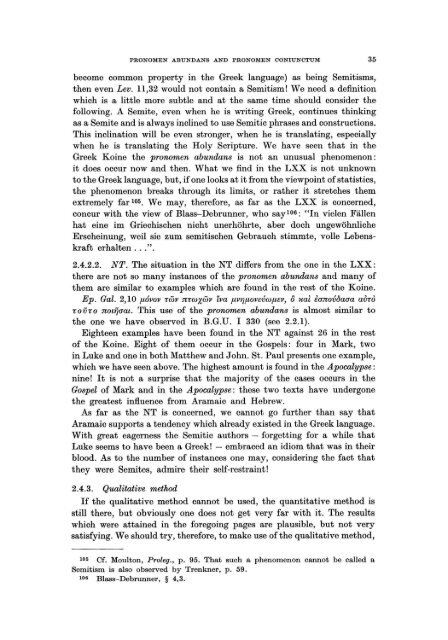Pronomen Abundans and Pronomen Coniunctum. A ... - DWC
Pronomen Abundans and Pronomen Coniunctum. A ... - DWC
Pronomen Abundans and Pronomen Coniunctum. A ... - DWC
You also want an ePaper? Increase the reach of your titles
YUMPU automatically turns print PDFs into web optimized ePapers that Google loves.
PRONOMEN ABUNDANS AND PRONOMEN CONIUNCTUM 35<br />
become common property in the Greek language) as being Semitisms,<br />
then even Lev. 11,32 would not contain a Semitism! We need a definition<br />
which is a little more subtie <strong>and</strong> at the same time should consider the<br />
following. A Semite, even when he is writing Greek, continues thinking<br />
as a Semite <strong>and</strong> is always inclined to use Semitic phrases <strong>and</strong> constructions.<br />
This inclination will be even stronger, when he is translating, especially<br />
when he is translating the Holy Scripture. We have seen that in the<br />
Greek Koine the pronomen abundans is not an unusual phenomenon:<br />
it does occur now <strong>and</strong> then. What we find in the LXX is not unknown<br />
to the Greek language, but, if one looks at it from the viewpoint of statistics,<br />
the phenomenon breaks through its limits, or rather it stretches them<br />
extremely far l05. We may, therefore, as far as the LXX is concerned,<br />
concur with the view of Blass-Debrunner, who sayl06: "In vielen Fällen<br />
hat eine im Griechischen nicht unerhöhrte, aber doch ungewöhnliche<br />
Erscheinung, weil sie zum semitischen Gebrauch stimmte, volle Lebenskraft<br />
erhalten ... ".<br />
2.4.2.2. NT. The situation in the NT differs from the one in the LXX:<br />
there are not so many instances of the pronomen abundans <strong>and</strong> many of<br />
them are similar to examples which are found in the rest of the Koine.<br />
Ep. Gal. 2,10 flÓVOV nov nTwxwv rva flv'YJflOVBVW!lfiV, 8 xal èanov(jaaa aVTo<br />
Toiho notijaat. This use of the pronomen abundans is almost similar to<br />
the one we have observed in B.G.U. I 330 (see 2.2.1).<br />
Eighteen examples have been found in the NT against 26 in the rest<br />
of the Koine. Eight of them occur in the Gospels: four in Mark, two<br />
in Luke <strong>and</strong> one in both Matthew <strong>and</strong> J ohn. St. Paul presents one example,<br />
which we have seen above. The highest amount is found in the Apocalypse:<br />
nine! It is not a surprise that the majority of the cases occurs in the<br />
Gospel of Mark <strong>and</strong> in the Apocalypse: these two texts have undergone<br />
the greatest influence from Aramaic <strong>and</strong> Hebrew.<br />
As far as the NT is concerned, we cannot go further than say that<br />
Aramaic supports a tendency which already existed in the Greek language.<br />
With great eagerness the Semitic authors - forgetting for a while that<br />
Luke sooms to have been a Greek! - embraced an idiom that was in their<br />
blood. As to the number of instances one may, considering the fact that<br />
they were Semites, admire their self-restraint!<br />
2.4.3. Qualitative method<br />
If the qualitative method cannot be used, the quantitative method is<br />
still there, but obviously one does not get very far with it. The results<br />
which were attained in the foregoing pages are plausible, but not very<br />
satisfying. We should try, therefore, to make use ofthe qualitative method,<br />
105 Cf. Moulton, Proleg., p. 95. That such a phenomenon cannot be called a<br />
Semitism is also observed by Trenkner, p. 59.<br />
106 Blass-Debrunner, § 4,3.
















